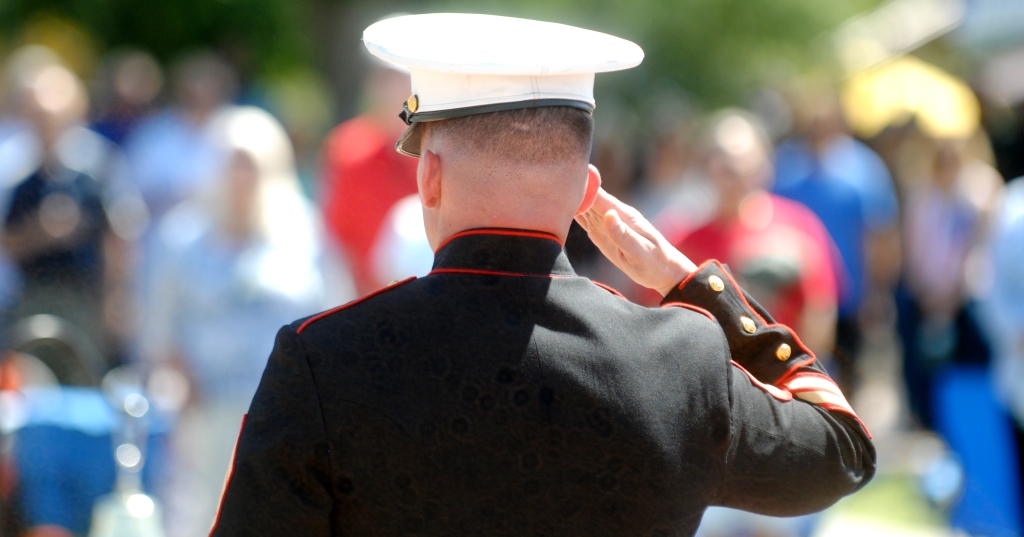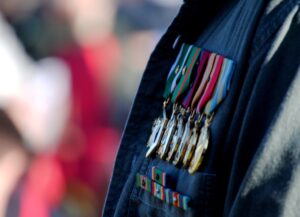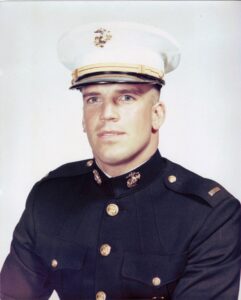Echoes of Valor

Writer Joseph J. Airdo



In the quiet suburb of Glen Ellyn, Illinois, a young man named John Bruce Capel was making his mark on the world, one athletic achievement at a time. Known simply as “Bruce” to his friends and family, he was a standout in baseball and football at Glenbard High School, known for his courage and character, both on and off the field.
“He lived around the corner from the high school football coach, Bill Duchon, who watched him grow up as an athlete and young man,” recounts Lisa Jones, Capel’s niece. “He was recruited to play at a lot of Division I universities, but he had always dreamed of playing at the University of Illinois.”
It was on the gridiron at Illinois where Capel truly shone, playing alongside football legend Dick Butkus.
“They roomed together on away games,” Jones shares. “Bruce recovered the game-changing fumble during the Rose Bowl [in 1964] and they went on to win the game.”
His talent and dedication were unmatched, earning him Academic All-American honorable mention and the admiration of his coaches, who marveled at his friendly demeanor and unwavering spirit.
After graduating, Capel’s path took an unexpected turn when he was commissioned as a second lieutenant in the Marine Corps and sent to The Basic School at Quantico, Virginia. There, he continued to excel as a linebacker on the football team, leaving a lasting impression on his coaches and teammates.
“I have met several of his coaches, and they have all told me that they commented, ‘Why haven’t we heard of this guy? He is such a good football player,’” Jones recalls. “Bruce’s response was, ‘I played opposite Butkus in college, basically in his shadow.’”
Tragically, Capel’s promising future was cut short in May 1966 when he was killed in action while leading a patrol that was ambushed by Viet Cong forces in Vietnam, just six weeks after his arrival.
“They came under Viet Cong fire and because Bruce was so tall when he stood up to assess the situation, the Viet Cong shot him in the head,” Jones says solemnly. “I believe only two of his platoon survived that day.”
His sacrifice, however, has not been forgotten. In Glen Ellyn, the Bruce Capel Hitters Club Award continues to inspire young football players to embody the courage and character that defined Capel’s life.
“To this day, the Glenbard West High School football team is nationally ranked and called ‘The Hitters,’ and my uncle was ‘The Original Hitter,’” Jones proudly notes. “He truly is a hometown hero of Glen Ellyn.”



Heroic Highlights
Capel’s story is just one of many that emanate from the hallowed grounds of Quantico, where a remarkable group of athlete Marines trained and played together before being called to serve in Vietnam. These 12 men — hailing from diverse backgrounds but united by their athletic prowess and unwavering dedication to duty — would go on to make the ultimate sacrifice, leaving behind a legacy of valor and sacrifice that continues to resonate today.
Gridiron greats who once graced Quantico’s fields made their mark through coaching and combat leadership. Capt. Ronald Howard Brown, a two-year letterman at Montana State University, transitioned from the trenches to mentoring as the offensive line coach for the Quantico staff team in 1965. Tragically, he was killed near Hue City in 1968 while heroically leading a convoy ambushed by superior North Vietnamese forces. Brown’s nephew remembers him as a larger-than-life figure who balanced professionalism with making football fun.
Joining Brown from the football ranks was Capt. Walter Judson Spainhour Jr., an All-American quarterback from the University of North Carolina. After undergoing elite training at Quantico, including reconnaissance and ranger courses, Spainhour reaffirmed his devotion through a letter home before making the ultimate sacrifice while leading his platoon during 1966’s Operation Deckhouse IV, earning a posthumous Silver Star.
The esteemed ranks of the Naval Academy proved a fertile ground for valor. First Lt. Thomas James Holden was a three-sport star at Annapolis known for his prankster spirit, earning recognition like the Most Valuable Defensive Player award at the 1964 Cotton Bowl. His grit and determination as an offensive lineman and linebacker with the Quantico team were immortalized through a posthumous Silver Star.
Classmate Capt. John Lee Prichard etched his name among Annapolis’ legendary athletes, starring in football and track. After transitioning to various coaching roles, Prichard displayed exceptional courage leading assaults against entrenched North Vietnamese forces in the battle for Khe Sanh in 1968, earning him the Silver Star and Bronze Star with valor before succumbing to wounds.
Another Marine who traced his athletic roots to Annapolis, Col. Robert Norman Smith, had carved an impressive path as a three-sport letterman and class president at Wyoming Seminary before the Naval Academy. His athletic prowess extended to the gridiron and throwing circles of the Quantico teams in the late 1940s. Smith’s unwavering leadership took him to the skies, but on an ill-fated 1969 reconnaissance mission over Vietnam, his aircraft disappeared without a trace, though his daughter’s solemn journey decades later honored his enduring legacy.
The quarterback ranks included Second Lt. Paul Frederick Cobb, known as Freddie, whose enthusiasm and leadership at Virginia Tech outshone any philosophical differences with coaches. At Quantico, Freddie showcased his abilities and inspirational tactics as the starting quarterback, which carried over to his courageous actions during Operation Allen Brook in 1968, rallying his men against intense enemy fire to earn a posthumous Navy Cross.
Second Lt. Paul Martin McGrath confronted skeptics of his size at Villanova, making a name for himself on the Quantico gridiron with a memorable tackle despite never playing for the Wildcats. The disappointment gave way to pride when McGrath’s poignant farewell letter, addressed “To Whom It May Concern,” received a posthumous reading in Congress after he fell as a member of the Basic School class with the highest casualty rate since the Korean War.
The trails and fields revealed athletic excellence in their own right. Second Lt. Tyrone Sidney Pannell was a Manhattan College track star, setting hurdle records and earning accolades at major meets before being commissioned as a Marine. While stationed at Quantico, he added his name to the base’s athletic lore before being killed in action while leading a patrol in Vietnam in 1967. His legacy lives on through honors like a namesake trophy at the Quantico Marine Track Competition and portrayals of the letters he penned home to his daughter in the book and film “Dear America.”
Representing the long-distance ranks, Capt. Willard Dale Marshall, a 1961 Naval Academy graduate, competed on the Navy track team before undergoing language training and serving as an interrogator and translator in Vietnam. He displayed heroic actions when his patrol was ambushed in 1968, posthumously earning the Bronze Star and forging an extraordinary bond with a former enemy who returned his poncho to his son decades later.
In Hawaii, Second Lt. Gene Smedley McMullen presaged his athletic skill, excelling in football, basketball and track at the prestigious Punahou School before starring on the gridiron at Penn State. Though his quiet demeanor earned him the nickname “Long Gene,” he found his warrior ethos through training at Quantico and artillery assignments prior to being killed by enemy fire in 1966 while serving as a forward observer.
These men, once teammates and brothers-in-arms, now stand as enduring symbols of the costs of war and the enduring bonds forged in service to our nation.



Memorial Moments
On Monday, May 27, as the Anthem community gathers for its annual Memorial Day ceremony at the Anthem Veterans Memorial, the stories of fallen heroes will take center stage. Organized by the Daisy Mountain Veterans, VFW Post 12031 and American Legion Post 128, the ceremony will highlight the personal stories of service members commemorated at the memorial who were killed in action or remain missing.
“Behind every veteran paver is the story of a spouse, mother, father, son, daughter and friend who served our nation with honor,” says Elizabeth Turner, a Daisy Mountain Veterans board member and Memorial Day ceremony organizer. “Sadly, 86 veterans commemorated at the AVM made the ultimate sacrifice during their service, and two are among the 83,204 unaccounted-for veterans. Memorial Day is a day set aside to remember them.”
For Jones, who donated funds to have one of the Marine seals on the AVM Marine Pillar dedicated to her uncle, the ceremony holds special significance.
“Every paver at the AVM has a story, and some pavers represent those who made the ultimate sacrifice,” she reflects. “I was thrilled to be able to help the Quantico Marine Athletes of the Sixties honor their fallen brothers with pavers at our AVM. While they have a memorial at The Basic School at Quantico for their fallen brothers, as a civilian, I cannot go on the base to see the memorial. At the AVM, these Marine athletes will be remembered and family members can come anytime to our memorial.”
The Quantico Marine athletes were an extraordinary group whose athletic abilities were matched only by their courage and dedication to service.
“What is so incredibly cool to me, and I just learned in the last few years, is that these 12 athletes were world-class athletes,” Jones marvels. “The track guys were truly some of the fastest men in the world. They held national and world records that still stand today in some of the relays. They were Olympians who represented our country and won gold medals. The football and basketball players could have played in the NFL and NBA, but they chose a different path for their athletics … and ultimately died defending their country.”
As the ceremony unfolds, with keynote addresses, the POW/MIA Missing Man Table ceremony and the symbolic ringing of a naval ship’s bell to honor each of the 86 veterans commemorated at the AVM who were killed in action, the echoes of these 12 Quantico Marine athletes will reverberate through the hearts and minds of all in attendance.
“As these Quantico Marine athlete octogenarians are becoming fewer, I represent the next generation to carry their torch and will always remember their fallen brothers and their sacrifice,” Jones vows solemnly. “Sharing the stories behind the pavers will bring the pavers to life and give them meaning. I think that highlighting the personal stories of servicemen and women at the AVM who were killed in action or remain missing in action really strengthens the meaning of Memorial Day.”
For Jones, ensuring these remarkable men are never forgotten is a profound duty.
“These veterans were spouses, parents, sons, daughters, aunts, uncles and friends who served our nation with honor, and we must remember them and their contribution to our country,” she says resolutely.
As “Taps” plays and the community observes a moment of reverent silence, the lives and legacies of the many selfless servicemembers who were killed in action or remain missing, including these 12 Quantico Marine athletes, will be celebrated — reminders of the profound costs of freedom and the enduring impact of courage in the face of adversity. Their stories, once echoing on the fields of Quantico, will resonate eternally as a testament to the unbreakable spirit of the U.S. Marine Corps.
Memorial Day Ceremony
Monday, May 27 // 9 a.m. // Anthem Veterans Memorial at Anthem Community Park // 41703 N. Gavilan Peak Parkway, Anthem // Free // onlineatanthem.com

